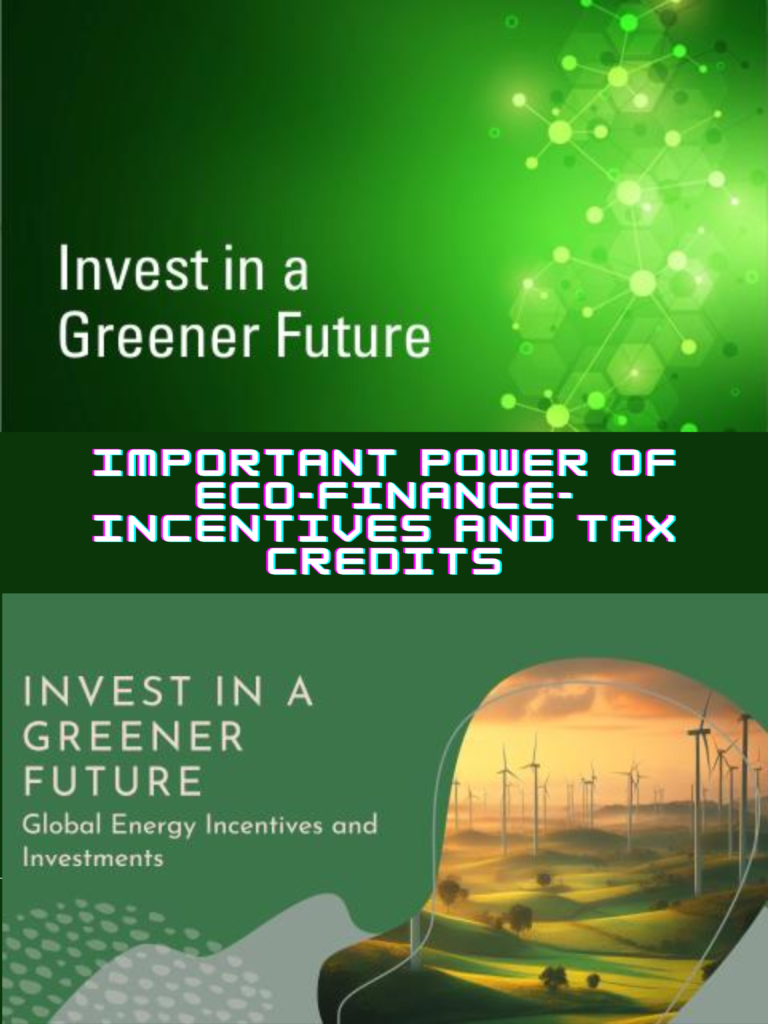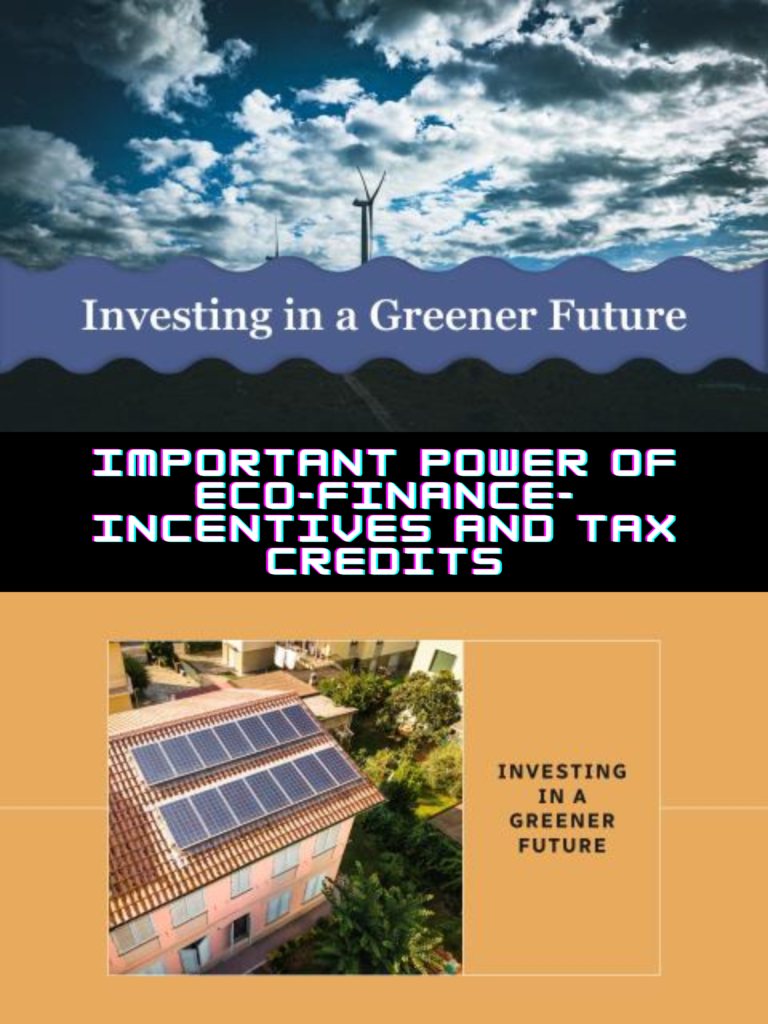Introduction:
Important Power of Eco-Finance-In the pursuit of a sustainable and eco-friendly future, governments, private entities, and international organizations are actively investing in and promoting green energy projects. This concerted effort not only aligns with environmental goals but also stimulates economic growth and innovation. Let’s delve into the diverse types of investments being made and the range of incentives and tax credits in place to catalyze the growth of green energy initiatives.

- Important Power of Eco-Finance: Incentives, and Tax Credits Shaping the Future of Green Energy
- Government Investments:
- Private Sector Contributions: Power of Eco-Finance
- International Organizations:
- Incentives and Tax Credits: Power of Eco-Finance
- Conclusion: Power of Eco-Finance
- Answer Covered People also ask
- Disclaimer
Important Power of Eco-Finance: Incentives, and Tax Credits Shaping the Future of Green Energy
Government Investments:
Governments worldwide are taking substantial strides to support green energy projects through direct investments. These investments often manifest in the form of:
- Grants and Subsidies: Governments allocate funds to provide grants and subsidies to renewable energy projects. These financial injections help offset initial setup costs and incentivize the adoption of green technologies.
- Infrastructure Development: Significant portions of national budgets are earmarked for the development of green energy infrastructure, including solar and wind farms, energy storage facilities, and smart grids.
- Research and Development: Governments invest in research and development initiatives to spur technological advancements in the green energy sector. This support encourages innovation and the discovery of more efficient and cost-effective renewable energy solutions.
Private Sector Contributions: Power of Eco-Finance
Private entities play a pivotal role in advancing green energy projects. Their investments take various forms:
- Venture Capital: Private venture capital firms invest in emerging green energy startups, providing crucial funding for the development and commercialization of innovative technologies.
- Corporate Sustainability Initiatives: Many corporations are integrating sustainability into their business models. They invest in renewable energy projects to reduce their carbon footprint, meet environmental goals, and enhance their brand reputation.
- Power Purchase Agreements (PPAs): Private companies often enter into long-term PPAs with renewable energy developers. These agreements guarantee a fixed price for the clean energy generated, providing financial stability for green projects.

International Organizations:
Global collaboration is key to addressing climate change. International organizations contribute to the growth of green energy projects through:
- Multilateral Development Banks (MDBs): Institutions like the World Bank and the Asian Development Bank invest in green energy projects in developing countries. Their support helps build sustainable energy infrastructure and facilitates the transition to clean energy sources.
- Climate Funds: Initiatives like the Green Climate Fund provide financial assistance to developing nations, supporting their efforts to mitigate and adapt to climate change. These funds often prioritize investments in renewable energy projects.
- Global Partnerships: Collaborative efforts between countries and international organizations foster knowledge exchange, technology transfer, and financial support for green energy initiatives.
Incentives and Tax Credits: Power of Eco-Finance
Governments incentivize green energy adoption through a variety of mechanisms:
- Investment Tax Credits (ITCs): Many countries offer ITCs to businesses and individuals investing in renewable energy projects. These credits reduce the overall tax liability, making green investments more financially attractive.
- Production Tax Credits (PTCs): PTCs provide a tax credit for each unit of electricity produced from qualifying renewable energy sources. This incentivizes increased production of clean energy.
- Feed-in Tariffs (FiTs): FiTs guarantee a fixed payment for renewable energy fed into the grid over a specified period. This stable income stream encourages investment in renewable energy infrastructure.
- Renewable Portfolio Standards (RPS): Governments set RPS, mandating a certain percentage of energy production to come from renewable sources. Companies that meet or exceed these standards may receive incentives or avoid penalties.
- Accelerated Depreciation: Some jurisdictions allow accelerated depreciation for renewable energy assets, enabling investors to recover their capital investment more quickly.
Conclusion: Power of Eco-Finance
The landscape of green energy investment is dynamic and promising, with governments, private entities, and international organizations collectively fostering a transition to a sustainable future. As investments continue to flow and incentives evolve, the global community is on a path to achieving cleaner, more resilient energy systems. This concerted effort not only benefits the environment but also establishes a foundation for long-term economic and social prosperity.
Answer Covered People also ask
1.What is the future of the green energy industry?
2.What are the green incentives?
3.What are the advantages of investing in green energy?
4.How does green investment affect the environment?
5.What are the benefits of tax incentives?
6.What is the meaning of tax credit and incentives?
7.What are the benefits of economic incentives?
8.What are the tax incentives for renewable energy in India?
9.What is the tax credit in India?
10.What are the tax incentives in India?
Disclaimer
This article has been created on the basis of internal data, information available publicly, and other reliable sources to be believed. The article may also include information which are the personal views/opinions of the authors. The information included in this article is for general, educational, and awareness purposes only and is not a full disclosure of every material fact.
All the information on this website i.e. World Virtual CFO – is published in good faith and for general information purposes only. World Virtual CFO does not make any warranties about the completeness, reliability, and accuracy of this information. These are my views for only information purposes. Any action you take upon the information you find on this website (World Virtual CFO), is strictly at your own risk. World Virtual CFO will not be liable for any losses and/or damages in connection with using our website. For details please refer to our disclaimer page.
Dr. Dinesh Sharma is an award-winning CFO and AI strategist with over two decades of experience in financial leadership, digital transformation, and business optimization. As the founder of multiple niche platforms—including WorldVirtualCFO.com—he empowers professionals and organizations with strategic insights, system structuring, and innovative tools for sustainable growth. His blogs and e-books blend precision with vision, making complex financial and technological concepts accessible and actionable.